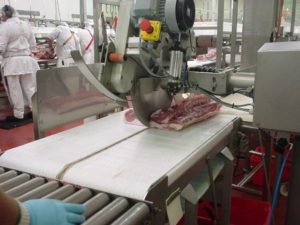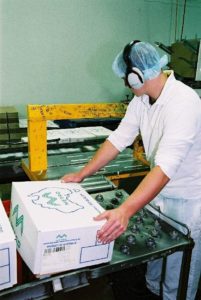
Controls such as laser-guided circular saws are most effective because they eliminate the risks of injury
© QAF Meats
In most cases there will be a combination of controls. Some less effective controls may be put in place in the short term, e.g. wearing ear plugs, before effective controls can be in place in the long term, e.g. replacing the noisy machine.
Step 4 – Review control measures
The control measures that are put in place should be reviewed regularly to make sure they work as planned. In some cases controls may not work as planned and/or the controls may result in new risks. For example the introduction of a robot to perform a task may eliminate the risks associated with operating that task but may lead to new risks such as risks associated with servicing and maintaining the robot.
Management is responsible to review the effectiveness of control measures and identify and control any new risks that have been introduced as a result of the controls. As a worker in the area or operator of equipment you may be the person who is implementing the controls and you may become aware of new risks. You should raise any health and safety issues with your supervisor. Don’t wait for an accident to happen. Report hazards and risks to your supervisor.
What is the role of workers in controlling risks?
Legally workers are required to look after their own health and safety and to take care of the health and safety of others around them. As part of achieving this you should notice hazards in your work area and the environment around you. If you are able to fix them, do so. If you cannot, then they should be reported to your supervisor. For example, rubbish on the floor may be a trip hazard. You may be able to remove the rubbish and eliminate the hazard. If you are unable to remove the rubbish you should report it to your supervisor. The supervisor is responsible for fixing the hazard. If you do not get satisfaction from the supervisor, you have the options of reporting the problem to the WHS representative, the WHS committee, the WHS coordinator or the union.
You should be made aware of progress and action taken to reduce the hazards you have reported.
How are workplace inspections conducted?
Regularly conducting workplace inspections is one method of identifying and controlling hazards before they cause accidents. Generally a standardised procedure in the form of a checklist is used to conduct inspections. This is to make sure that no area is left out.
Supervisors generally conduct regular inspections of their work area. Inspections may also be conducted by the WHS representatives, the WHS committee and the WHS coordinator. Workers should report any hazards they see to their supervisors and raise health and safety matters when the inspections are being conducted. Workers may also be involved in identifying and implementing control measures to reduce the risks of accidents as a result of inspections.
What are common hazards in the meat processing industry?
There are two general categories of hazards. These are hazards to health and hazards to safety. Health hazards may result in illness or disease. For example, personnel in meat processing plants may be exposed to bacteria such as E. Coli, viruses such as HIV or Hepatitis B or diseases such as Q Fever contracted from animals. Hazards to health may not be clear cut. Presenting symptoms may vary from individual to individual, may be slow to develop or may be cumulative.
Safety hazards may lead to an accident with damage to a person, property, plant or equipment. Safety hazards tend to be easier to find. There is usually a direct relationship between the safety hazard and its consequences.
Every industry has hazards which are common. Some hazards are common across many industries. For example manual handling hazards are significant cause of injury and subsequent workers’ compensation claims across Australia.
Hazards generally arise from the following aspects of work and their interaction:
- physical work environment (e.g. electricity, lighting, exposure to noise, heat, cold and radiation, confined spaces, contact with moving objects)
- equipment, materials and substances used (e.g. installation, use, maintenance and storage of equipment, use of knives)
- work tasks and how they are performed (e.g. manual handling)
- work design and management.
The next section applies the risk control process to the management of common hazards in the meat industry to reduce the risks to the lowest possible levels. The common hazards covered are:
- zoonotic diseases
- manual handling
- hazards that cause slips, trips and falls
- hazards related to plant, equipment and tools
- hazards of working with a knife
- extremes of temperature – cold and hot
- hazardous substances
- working at heights
- Noise

Conveyor belts are engineering controls to reduce manual handling injuries
Courtesy of Meat and Livestock Australia
